A Compact and Multi-Stack Electromagnetic Bandgap Structure for Gigahertz Noise Suppression in Multilayer Printed Circuit Boards
Abstract
:1. Introduction
2. Design of Compact and Multi-Stack Electromagnetic Bandgap (CMS-EBG) Structure
2.1. Geometrical Design
2.2. Characteristic–Impedance Analysis
3. Floquet-Bloch Analysis
4. Results and Discussion
5. Conclusions
- This paper proposes a multi-stack technique for the compact EBG structure in MPCBs. Sixteen EBG cells are efficiently arranged in the compact area of the 2 × 2 array size. The vertically stacked EBG patches are connected through the original configuration of the vertical branch. The consistent use of the vertical branch ensures good noise suppression and a simple analysis for the multi-stack EBG structure.
- The noise suppression characteristics of the CMS-EBG structure are predicted by applying the Floquet-Bloch analysis. To obtain the dispersion characteristics, the analytical equation based on the equivalent circuit model is derived, and the results are proven by comparison with the FEM simulation. For an example structure, the low- and high-cutoff frequencies are predicted as 1.98 GHz and 6.42 GHz, respectively. The CMS-EBG structure should significantly mitigate GHz noise in this frequency range. In addition, the main design parameter effect is thoroughly examined.
- From the measurements of the fabricated CMS-EBG structure in MPCBs, the low- and high-cutoff frequencies are 2.7 GHz and 7.3 GHz, which indicate a broad noise suppression region. The port distance is notably short (4 mm) and less than the unit cell length of 12 mm. The experimental results verify the distinguished noise suppression characteristics of the CMS-EBG structure with a compact size and a short source-to-victim distance.
Acknowledgments
Author Contributions
Conflicts of Interest
References
- Swaminathan, M.; Kim, J.; Novak, I.; Libous, J.P. Power distribution networks for system-on-package: Status and challenges. IEEE Trans. Adv. Packag. 2004, 27, 286–300. [Google Scholar] [CrossRef]
- Li, E.P.; Wei, X.C.; Cangellaris, A.C.; Liu, E.X.; Zhang, Y.J.; D’Amore, M.; Kim, J.; Sudo, T. Progress Review of Electromagnetic Compatibility Analysis Technologies for Packages, Printed Circuit Boards, and Novel Interconnects. IEEE Trans. Electromagn. Compat. 2010, 52, 248–265. [Google Scholar]
- Swaminathan, M.; Chung, D.; Grivet-Talocia, S.; Bharath, K.; Laddha, V.; Xie, J. Designing and modeling for power integrity. IEEE Trans. Electromagn. Compat. 2010, 52, 288–310. [Google Scholar] [CrossRef]
- Wu, T.L.; Chuang, H.H.; Wang, T.K. Overview of power integrity solutions on package and PCB: Decoupling and EBG isolation. IEEE Trans. Electromagn. Compat. 2010, 52, 346–356. [Google Scholar] [CrossRef]
- Hwang, C.; Kim, J.; Achkir, B.; Fan, J. Analytical transfer functions relating power and ground voltage fluctuations to jitter at a single-ended full-swing buffer. IEEE Trans. Compon. Packag. Manuf. Technol. 2013, 3, 113–125. [Google Scholar] [CrossRef]
- Cui, W.; Fan, J.; Ren, Y.; Shi, H.; Drewniak, J.L.; DuBroff, R.E. DC power-bus noise isolation with power-plane segmentation. IEEE Trans. Electromagn. Compat. 2003, 45, 436–443. [Google Scholar] [CrossRef]
- Fan, J.; Drewniak, J.L.; Shi, H.; Knighten, J.L. DC power-bus modeling and design with a mixed-potential integral-equation formulation and circuit extraction. IEEE Trans. Electromagn. Compat. 2001, 43, 426–436. [Google Scholar] [CrossRef]
- Leone, M.; Friedrich, M.; Mantzke, A. Efficient broadband circuit-modeling approach for parallel-plane structures of arbitrary shape. IEEE Trans. Electromagn. Compat. 2013, 55, 941–948. [Google Scholar] [CrossRef]
- Zhang, M.S.; Tan, H.Z.; Mao, J.F. A novel layer stack-up with free cavity resonance for high-performance power noise suppression. IEEE Trans. Compon. Packag. Manuf. Technol. 2014, 4, 1973–1980. [Google Scholar] [CrossRef]
- Abhari, R.; Eleftheriades, G.V. Metallo-dielectric electromagnetic bandgap structures for suppression and isolation of the parallel-plate noise in high-speed circuits. IEEE Trans. Microw. Theory Tech. 2003, 51, 1629–1639. [Google Scholar] [CrossRef]
- Wu, T.Z.; Wang, C.C.; Lin, Y.H.; Wang, T.-K.; Chang, G. A novel power plane with super-wideband elimination of ground bounce noise on high speed circuits. IEEE Microw. Wirel. Compon. Lett. 2005, 15, 174–176. [Google Scholar]
- Wu, T.Z.; Lin, Y.H.; Wang, T.K.; Wang, C.C.; Chen, S.T. Electromagnetic bandgap power/ground planes for wideband suppression of ground bounce noise and radiated emission in high-speed circuits. IEEE Trans. Microw. Theory Tech. 2005, 53, 2935–2942. [Google Scholar]
- Kim, K.H.; Schutt-Aine, J.E. Design of EBG power distribution networks with VHF-B and cutoff frequency and small unit cell size for mixed-signal systems. IEEE Microw. Wirel. Compon. Lett. 2007, 17, 489–491. [Google Scholar] [CrossRef]
- Choi, J.; Govind, V.; Swaminathan, M.; Bharath, K. Noise isolation in mixed-signal systems using alternating impedance electromagnetic bandgap (AI-EBG) structure-based power distribution network (PDN). IEEE Trans. Adv. Packag. 2010, 33, 2–12. [Google Scholar] [CrossRef]
- Kim, M.; Koo, K.; Hwang, C.; Shim, Y.; Kim, J.; Kim, J. A compact and wideband electromagnetic bandgap structure using a defected ground structure for power/ground noise suppression in multilayer packages and PCBs. IEEE Trans. Electromagn. Compat. 2012, 54, 689–695. [Google Scholar]
- De Paulis, F.; Nisanci, M.H.; Orlandi, A. Practical EBG application to multilayer PCB: Impact on power integrity. IEEE Trans. Electromagn. Compat Mag. 2012, 1, 60–65. [Google Scholar] [CrossRef]
- Choi, J. Ultimate noise isolation in high-speed digital systems on packages and printed circuit boards. Electr. Lett. 2013, 49, 594–595. [Google Scholar] [CrossRef]
- Kim, M.; Koo, K.; Shim, Y.; Hwang, C.; Pak, J.S.; Ahn, S.; Kim, J. Vertical stepped impedance EBG (VSI-EBG) structure for wideband suppression of simultaneous switching noise in multilayer PCBs. IEEE Trans. Electromagn. Compat. 2013, 55, 307–314. [Google Scholar] [CrossRef]
- Kim, M.; Kam, D.G. A wideband and compact EBG structure with a circular defected ground structure. IEEE Trans. Compon. Packag. Manuf. Technol. 2014, 4, 496–503. [Google Scholar] [CrossRef]
- Kasahara, Y.; Toyao, H.; Hankui, E. Compact and multiband electromagnetic bandgap structures with adjustable bandgaps derived from branched open-circuit lines. IEEE Trans. Microw. Theory Tech. 2017, 65, 2330–2340. [Google Scholar] [CrossRef]
- Yoo, J.; Park, J.; Park, H.; Kim, J.; Shim, Y.; Song, T.; Kim, J. Analysis of the Vertical Electromagnetic Bandgap Structures in the Power Distribution Network for the Multi-layer Printed Circuit Board. In Proceedings of the 10th Electronics Packaging Technology Conference, Singapore, 9–12 December 2008; pp. 1381–1386. [Google Scholar]
- Shen, C.K.; Chen, C.H.; Han, D.H.; Wu, T.L. Modeling and analysis of bandwidth-enhanced multilayer 1-D EBG with bandgap aggregation for power noise suppression. IEEE Trans. Electromagn. Compat. 2015, 57, 858–867. [Google Scholar] [CrossRef]
- Wang, C.L.; Shiue, G.H.; Guo, W.D.; Wu, R.B. A systematic design to suppress wideband ground bounce noise in high-speed circuits by electromagnetic-bandgap-enhanced Split Powers. IEEE Trans. Microw. Theory Tech. 2006, 54, 4209–4217. [Google Scholar] [CrossRef]
- Wang, C.C.; Yu, Y.M.; de Paulis, F.; Scogna, A.C.; Orlandi, A.; Chiou, Y.P.; Wu, T.L. Bandwidth enhancement based on optimized via location for multiple vias EBG power/ground planes. IEEE Trans. Compon. Packag. Manuf. Technol. 2012, 2, 332–341. [Google Scholar] [CrossRef]
- Ansys, Inc. High Frequency Structure Simulator. Available online: http://www.ansys.com/ (accessed on 1 May 2017).
- Standard for Validation of Computational Electromagnetics Computer Modeling and Simulation—Part 1; IEEE: New York, NY, USA, 2008; p. P1597.1.
- Duffy, A.P.; Martin, A.J.M.; Orlandi, A.; Antonini, G.; Benson, T.M.; Woolfson, M.S. Feature Selective Validation (FSV) for validation of computational electromagnetics (CEM). Part I—The FSV method. IEEE Trans. Electromagn. Compat. 2006, 48, 449–459. [Google Scholar] [CrossRef]
- Orlandi, A.; Duffy, A.P.; Archambeault, B.; Antonini, G.; Coleby, D.E.; Connor, S. Feature Selective Validation (FSV) for validation of computational electromagnetics (CEM). Part II—Assessment of FSV performance. IEEE Trans. Electromagn. Compat 2006, 48, 460–467. [Google Scholar]
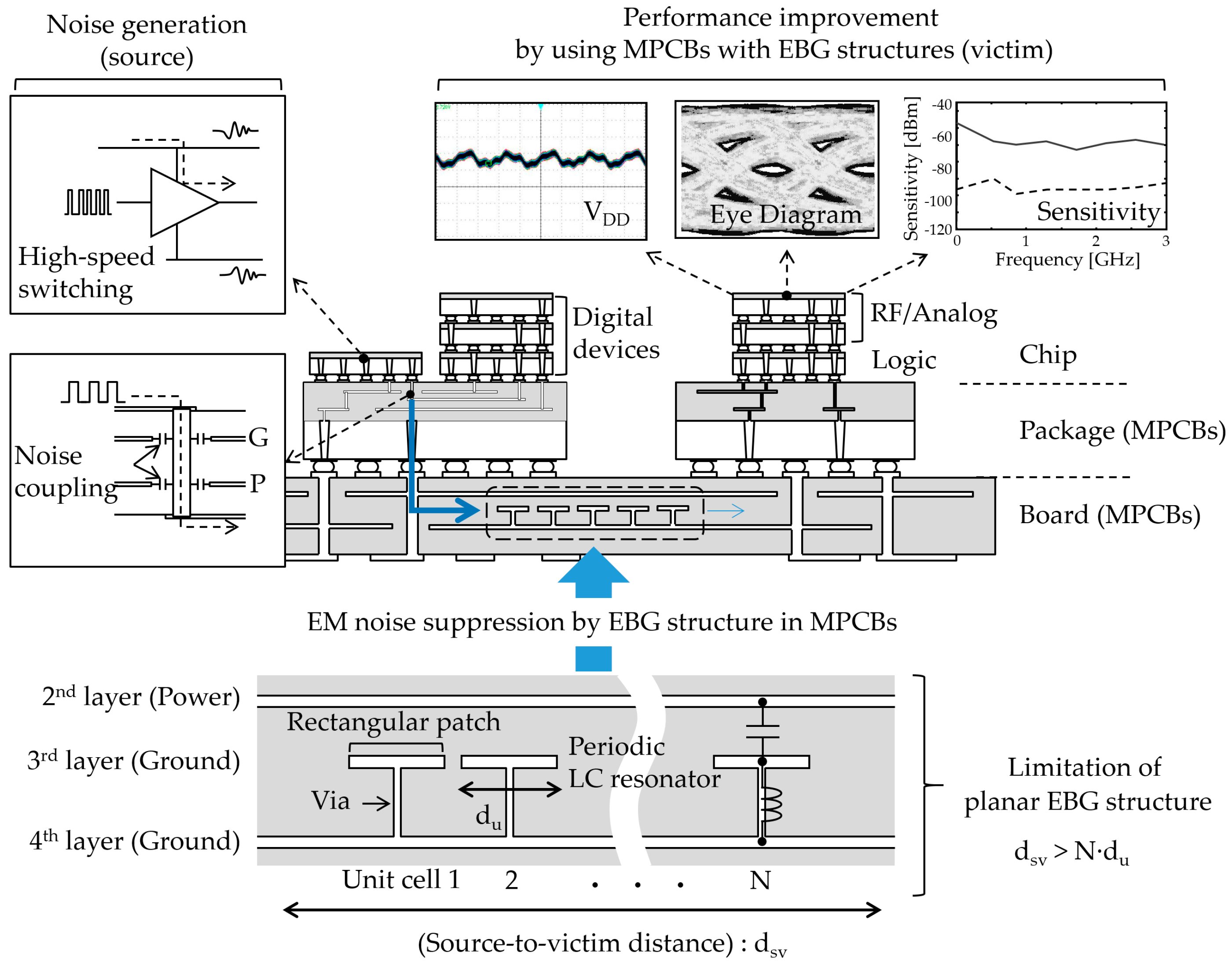
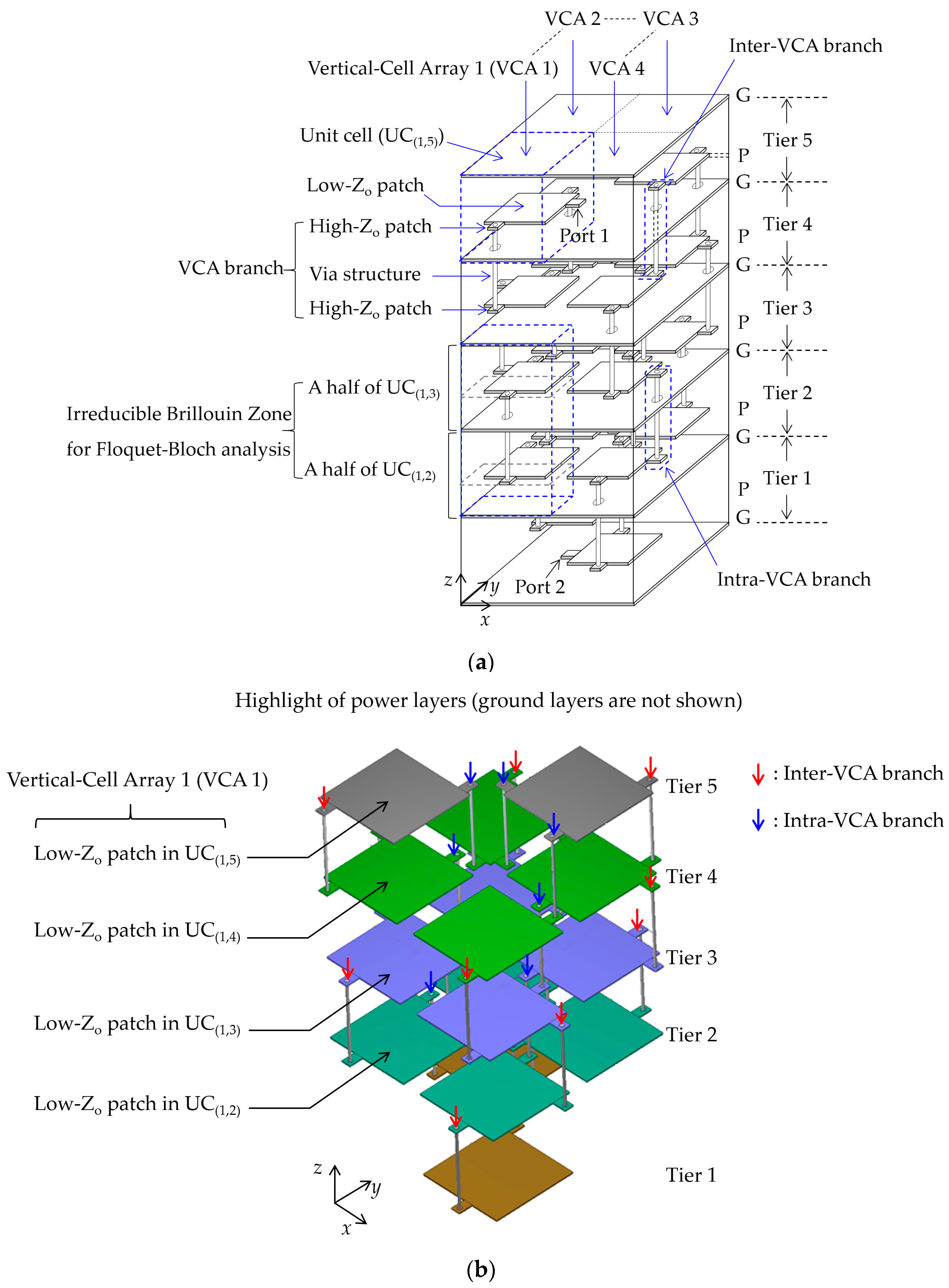


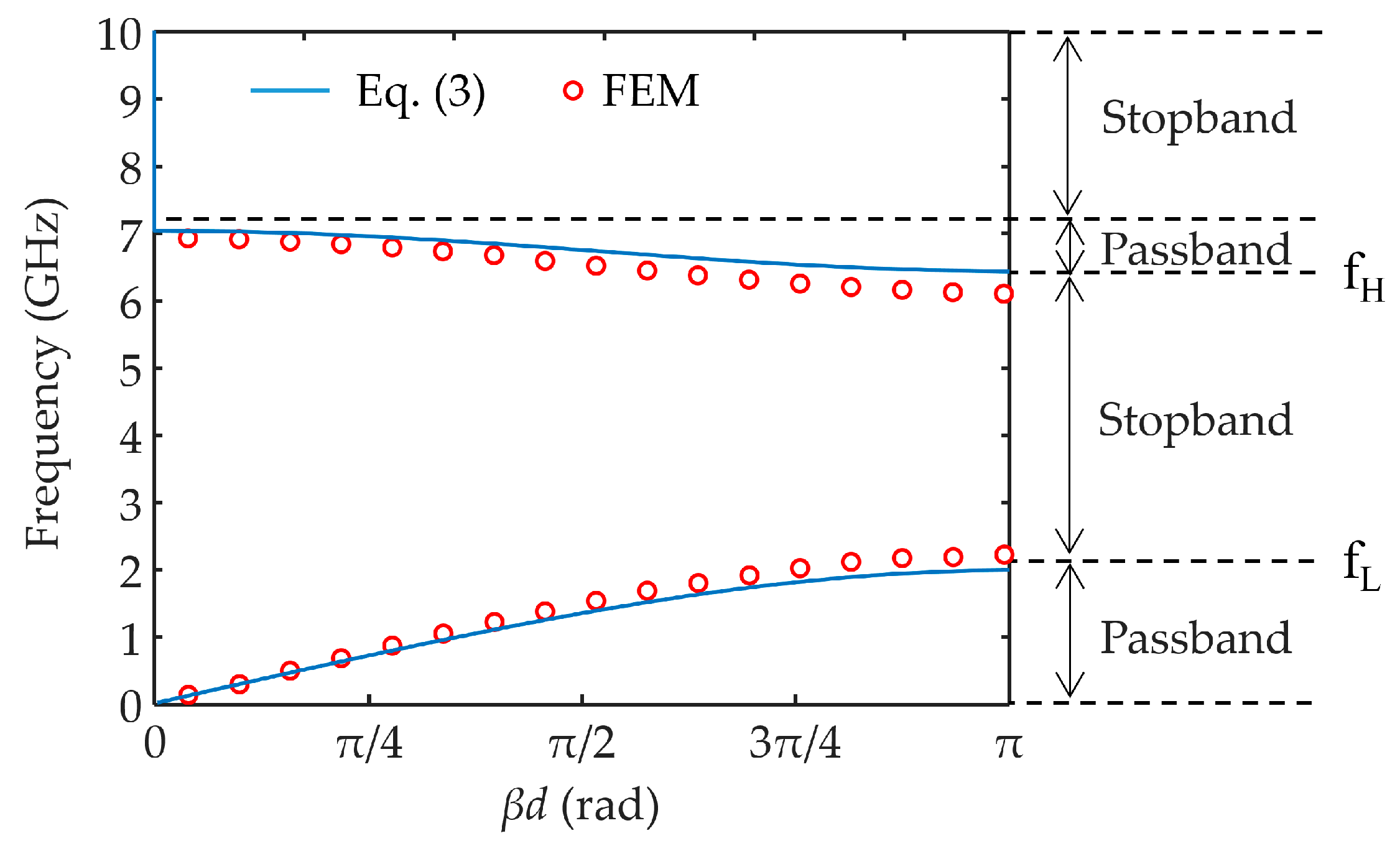
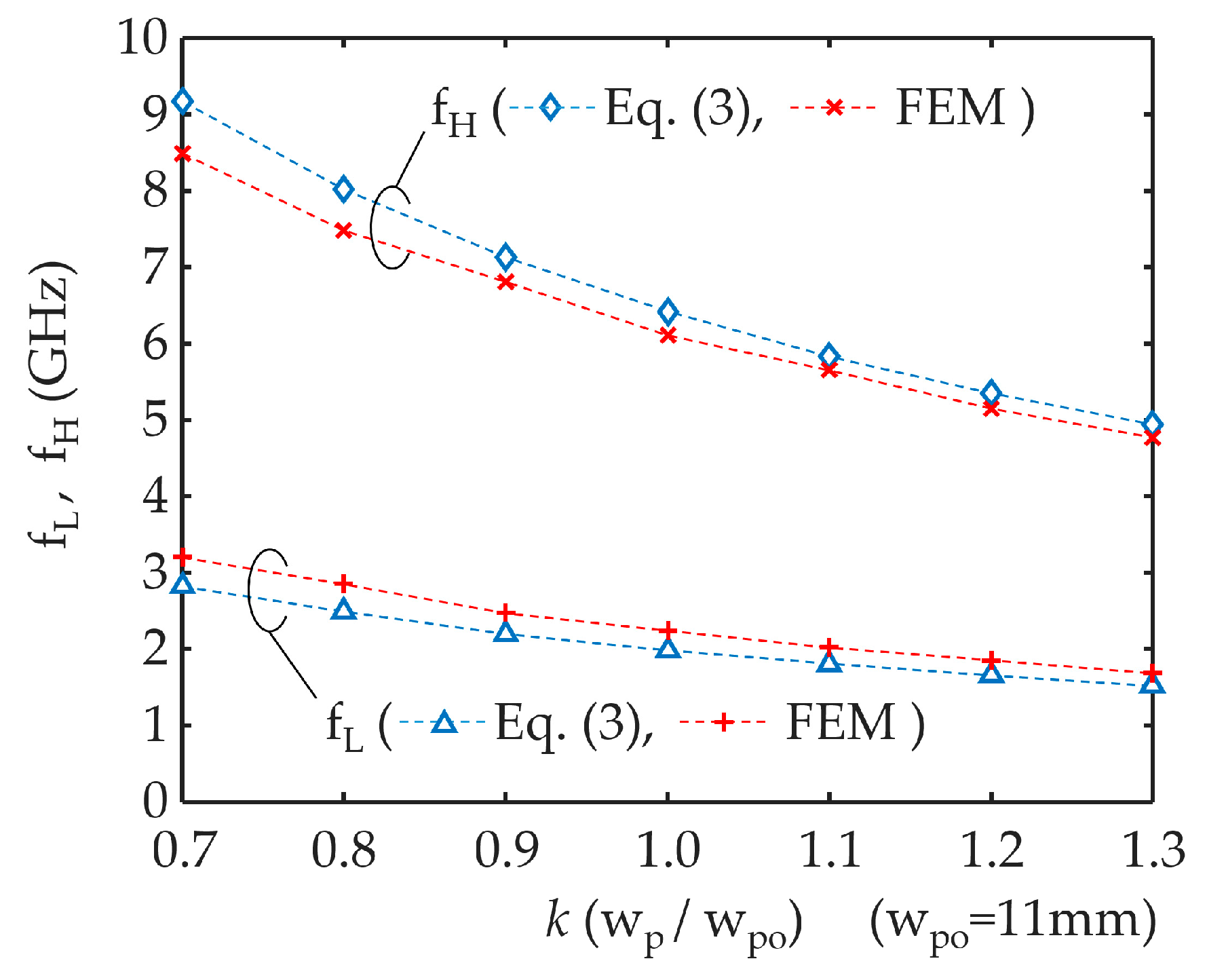
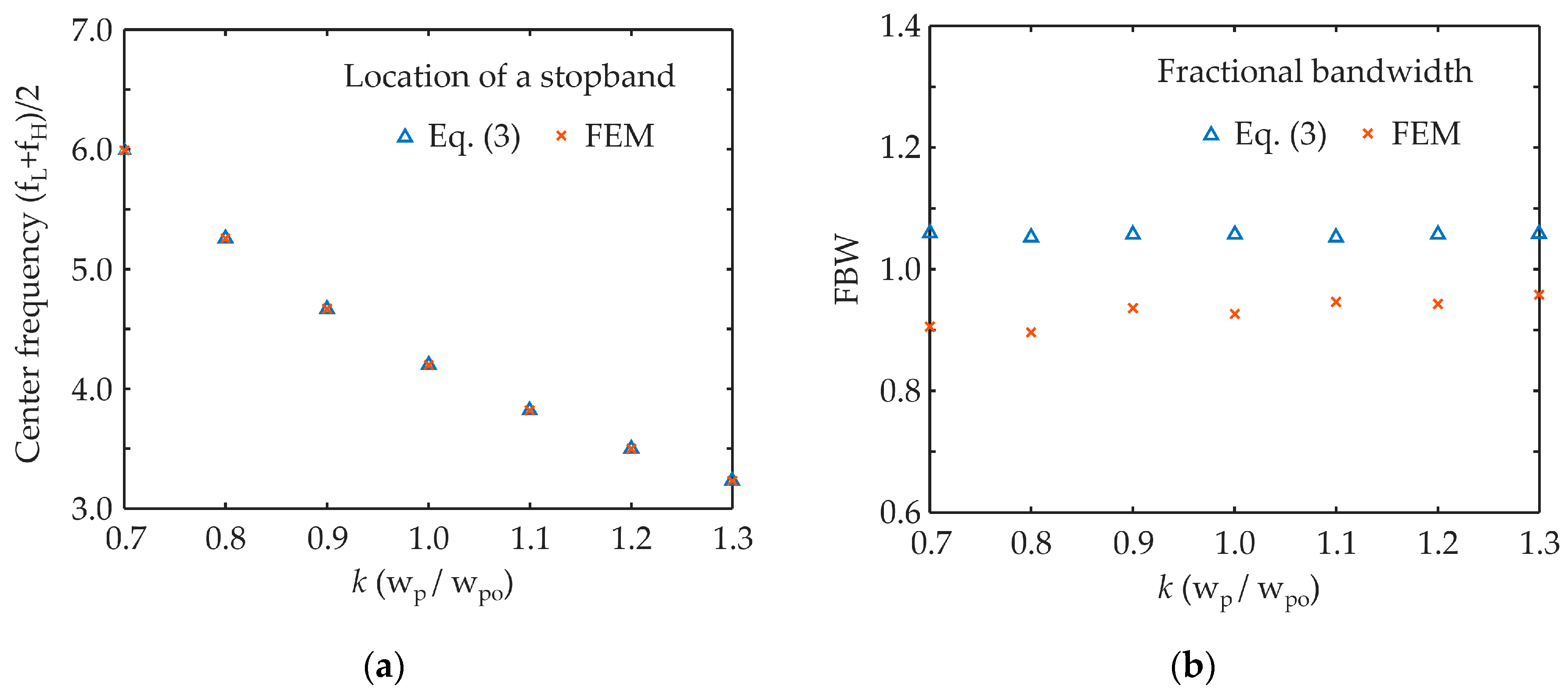

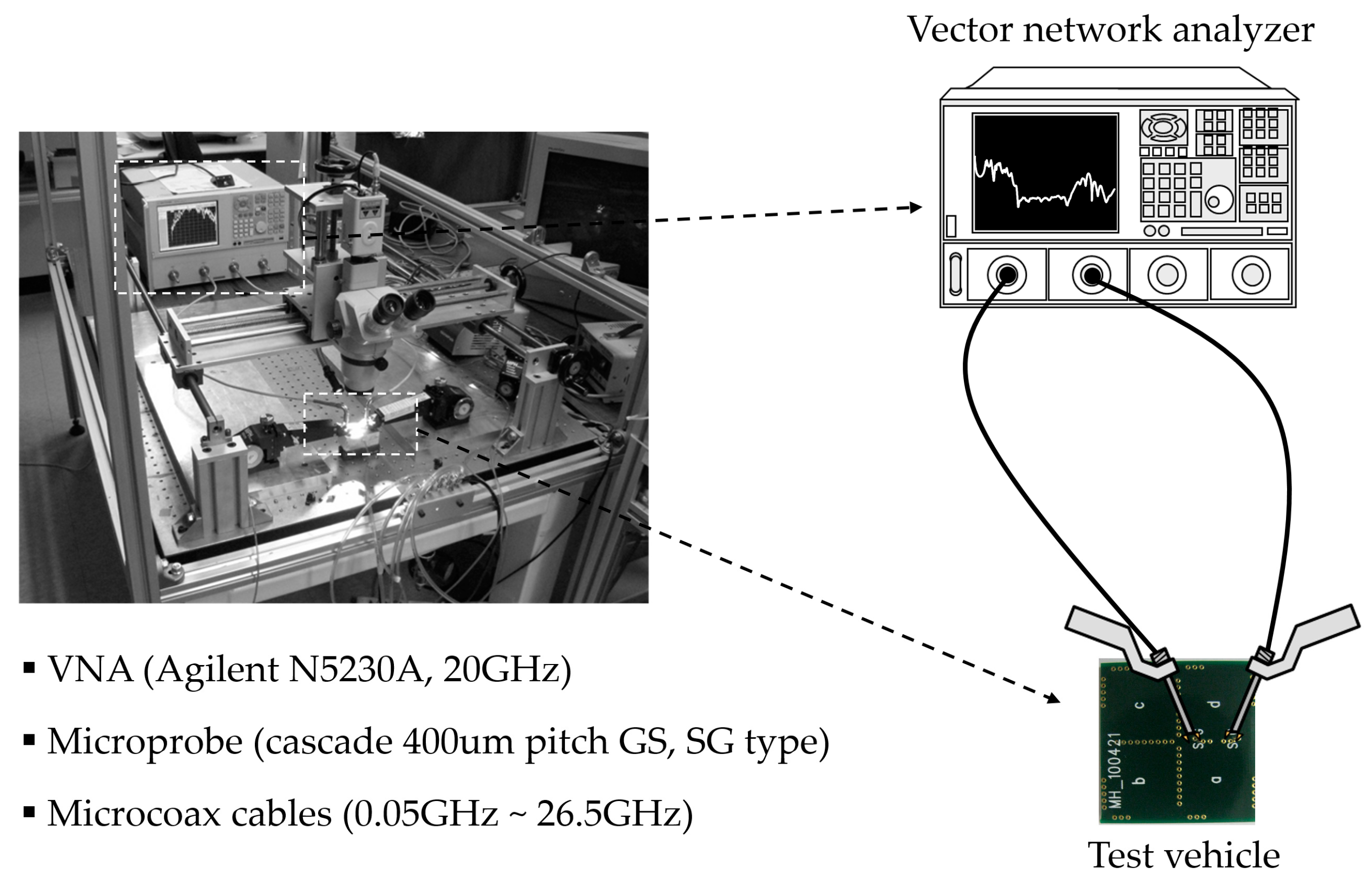
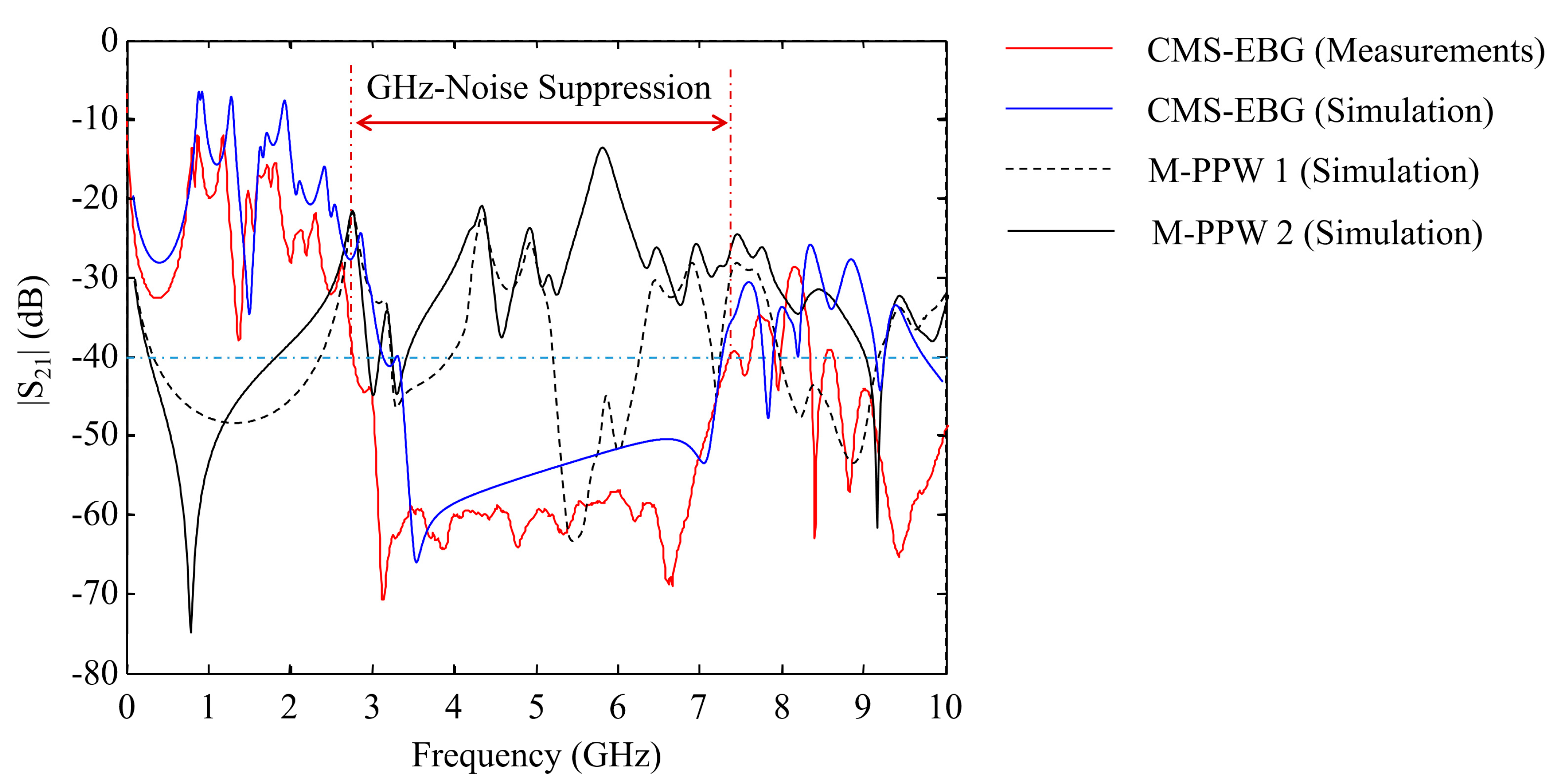

| Parameters | k (wp/wpo) | |||||||
|---|---|---|---|---|---|---|---|---|
| 0.7 | 0.8 | 0.9 | 1.0 | 1.1 | 1.2 | 1.3 | ||
| ZoL (Ω) | 1.16 | 1.03 | 0.90 | 0.82 | 0.75 | 0.68 | 0.62 | |
| Equation (3) (GHz) | fL | 2.82 | 2.49 | 2.20 | 1.98 | 1.81 | 1.65 | 1.52 |
| fH | 9.17 | 8.02 | 7.13 | 6.42 | 5.83 | 5.35 | 4.94 | |
| fC 1 | 6.00 | 5.23 | 4.67 | 4.20 | 3.82 | 3.50 | 3.23 | |
| FBW 2 | 1.06 | 1.05 | 1.06 | 1.06 | 1.05 | 1.06 | 1.06 | |
| FEM (GHz) | fL | 3.2 | 2.85 | 2.47 | 2.24 | 2.02 | 1.85 | 1.68 |
| fH | 8.49 | 7.48 | 6.81 | 6.11 | 5.65 | 5.15 | 4.77 | |
| fC | 5.85 | 5.17 | 4.64 | 4.18 | 3.84 | 3.50 | 3.23 | |
| FBW | 0.91 | 0.90 | 0.94 | 0.93 | 0.95 | 0.94 | 0.96 | |
© 2017 by the authors. Licensee MDPI, Basel, Switzerland. This article is an open access article distributed under the terms and conditions of the Creative Commons Attribution (CC BY) license (http://creativecommons.org/licenses/by/4.0/).
Share and Cite
Kim, M.; Ahn, S. A Compact and Multi-Stack Electromagnetic Bandgap Structure for Gigahertz Noise Suppression in Multilayer Printed Circuit Boards. Appl. Sci. 2017, 7, 804. https://doi.org/10.3390/app7080804
Kim M, Ahn S. A Compact and Multi-Stack Electromagnetic Bandgap Structure for Gigahertz Noise Suppression in Multilayer Printed Circuit Boards. Applied Sciences. 2017; 7(8):804. https://doi.org/10.3390/app7080804
Chicago/Turabian StyleKim, Myunghoi, and Seungyoung Ahn. 2017. "A Compact and Multi-Stack Electromagnetic Bandgap Structure for Gigahertz Noise Suppression in Multilayer Printed Circuit Boards" Applied Sciences 7, no. 8: 804. https://doi.org/10.3390/app7080804





